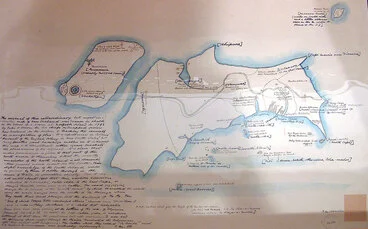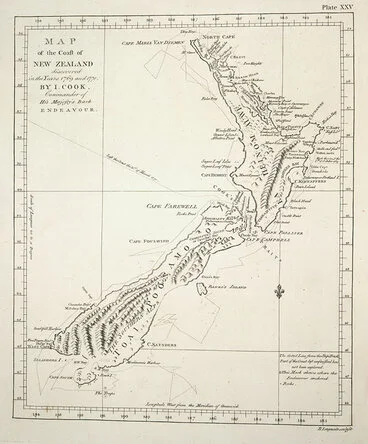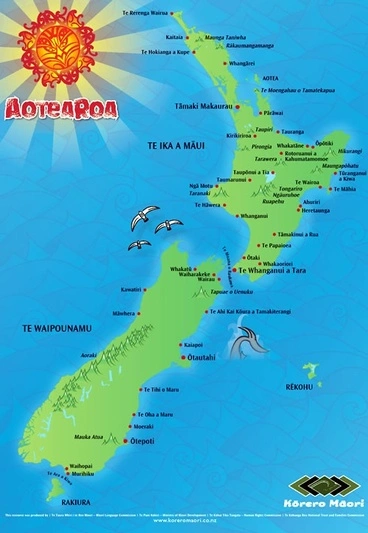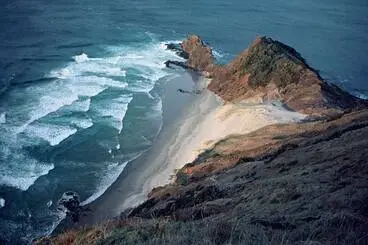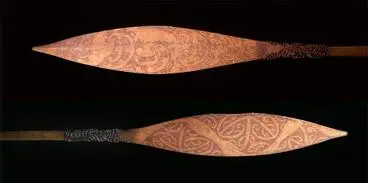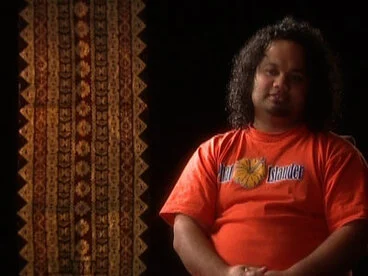Tuki Te Terenui Whare Pirau’s map
A DigitalNZ Story by National Library Services to Schools
This first Māori map of Aotearoa was drawn by the chief Tuki te Terenui Whare Pirau in 1793. It was drawn in chalk on the floor of Government House on Norfolk island.
These resources and text relate to the background and context of the first Māori map of Aotearoa, drawn in 1793. They have been sourced and collated from DigitalNZ and other websites.
Background
Tuki was the son of a tohunga, one of two young Māori kidnapped in 1793 off the Cavalli Islands and taken to Norfolk Island to teach convicts how to dress flax, a singularly unsuccessful project as preparing and using flax was largely women’s work. The map was drawn to better communicate with, and possibly at the behest of, the lieutenant-governor of Norfolk, Philip King. It is possible that Tuki was attempting to indicate where he and Huru should be returned to, which eventually did happen. The map was initially drawn by chalk on the floor of a room and then transferred to paper. Annotations were mostly done by King’s secretary.
The map is not to scale and the area Tuki was familiar with (Northland) is shown disproportionately large. He was clearly aware of the South Island’s existence, despite never having travelled there.
The double dotted line indicates the pathway taken by spirits of the dead departing for the underworld.
Other details, presumably dictated by Tuki, relate to the political alliances, fighting strength, location and size of local iwi populations.
Source: Polynesian Navigation and Tuki’s Map, National Library of New Zealand (accessed 13 August 2018)
Context
The Polynesian ancestors of Māori successfully reached and settled New Zealand around 200 years before Columbus ventured across the Atlantic.
They sailed thousands of kilometres to get here and all the evidence indicates intent. Routes were preserved in memory or recorded in song. The navigators on these voyages were guided by the night skies and other natural phenomena.
Indicators of position or progress would have included island landmarks; wind, cloud and weather system behaviour; the position of the sun; ocean swell patterns; migrating birds and whales; floating driftwood and vegetation; the colour of the sea and the “scent of nearby land”. They developed star compasses and are known to have fashioned stick charts as navigational aids.
Māori likewise developed an ability to navigate their new homeland, weaving place names and overland route descriptions into oral histories and traditions that were passed from generation to generation. Māori had no need for print maps – theirs was an oral cartography.
However, on the arrival of Europeans, Māori were quick to learn the cartographic methods used by the visitors. This is one of the earliest known examples of a map drawn by Māori.
Source: Polynesian Navigation and Tuki’s Map, National Library of New Zealand (accessed 13 August 2018)
Tuki's 1793 map of New Zealand
Manatū Taonga, the Ministry for Culture and Heritage
Fertile questions
Imagine yourself somewhere on Tuki’s map. What do you see?
What makes Tuki’s map unique?
What can maps tell us?
What is your question?
Cook’s map of New Zealand
Manatū Taonga, the Ministry for Culture and Heritage
Quick facts
- After Tuki had drawn his map of Aotearoa, Governor King showed him a copy of Captain Cook’s map of New Zealand. Tuki looked at it and told King that Cook had left off the Hokianga River.
- When Governor King’s returned the kidnapped Tuki he also gave him presents including: “handaxes, carpenters’ tools, scissors, razors, hoes, spades, seeds — including wheat, maize, and peas — ten young sows and two boars... King was deliberately introducing items for which a demand might grow, as their use (by Tuki’s iwi) became understood.
Māori placenames map
Manatū Taonga, the Ministry for Culture and Heritage
Cape Rēinga
Manatū Taonga, the Ministry for Culture and Heritage
Doubtless Bay
Whangarei Libraries
Other resources
500 Years of European colonialism — video timeline that covers colonial expansion.
A chart of New Zealand by James Cook — Cook's completed chart of New Zealand.
Māori Maps — find your way to the tribal marae of Aotearoa New Zealand.
Ngāi Tahu atlas — view over 1,000 original Māori place names.
Renaming Aotearoa New Zealand— how James Cook and his crew renamed the landscapes they encountered.
Tuki’s Universe by Judith Binney New Zealand Journal of History, 38, 2 (2004)
Paddles obtained on Cook's first voyage
Manatū Taonga, the Ministry for Culture and Heritage
Children of the Migration
NZ On Screen
This story was compiled and curated by Te Puna Mātauranga o Aotearoa | National Library of New Zealand, Services to Schools staff, in 2019.
